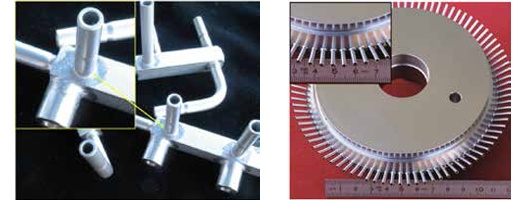
Gap-less, smooth and more corrosion resistant components without further work thanks to the Vacuum Brazing Technology.
The hot water components images are a typical example of a material-efficient modular design in mechanical and apparatus engineering. Individual parts are manufactured from simple, readily available semi-finished products, which are subsequently brazed.
The requirements for the component used in the food industry have to be free of gaps and corrosion resistant. Therefore, the individual parts are made of austenitic CrNi steel, brazed with a nickel-based brazing alloy with a high chromium content. An appropriate furnace size allows to treat several thousand components in a single brazing process. The vacuum atmosphere ensures absolutely smooth, gap-free components that do not require any further processing.
These advantages are also used for a component that is used to distribute a centrally fed fluid to 100 output points. The analytical conditions require the use of titanium alloy. Again, the demands for the brazed joint have to be gap-free and corrosion resistant. The brazing process was carried out with a titanium-based brazing alloy, which enables a brazing temperature of < 950 °C that is below the α-β-transus temperature. Again, the use of the vacuum brazing production technique makes a rework unnecessary.



 Listemann AG
Listemann AG Listemann Polska Sp.z o.o.
Listemann Polska Sp.z o.o.